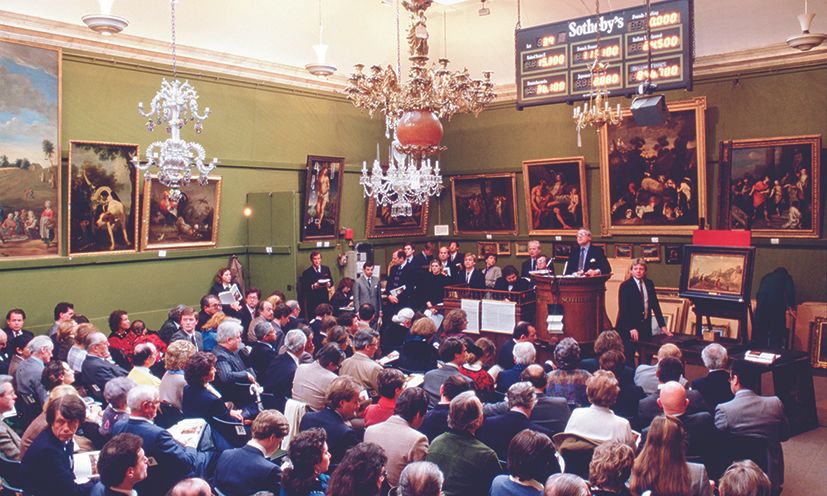A Sotheby’s sale in London in 1986; rising inflation in the 1970s led to art being viewed in the same way as traditional investment assets, and auction results as a market barometers
Photo: Marc Deville/ Gamma-Rapho via Getty Images
Inflation is forecast to fall in the UK and US this year, though at present it remains stubbornly persistent in both countries. The implications are clear for consumers; for the art market, less so. After the sugar high of the Paul G. Allen sale in November, auctioneers and dealers suddenly became fearful of an impending downturn. With the outcome of these economic gyrations still uncertain, it is worth revisiting the inflationary period of the 1970s, which effectively launched the art world as we know it today.
US inflation hit 11.05% in 1974, then declined slightly, rose again to 11.25% in 1979, and peaked at 13.55% in 1980. Art tends to be a lagging indicator, however, and the market did not respond immediately to these jumps. According to the Mei Moses Art Index, art prices were relatively flat from the mid-1950s until the mid-1970s. Thereafter, prices began going up, at first gradually and then, from about 1987 to 1989, precipitously. At a more granular level, a parallel trend can be observed in the prices of Egon Schiele watercolours. In 1972, a top-quality watercolour by the artist sold for $26,000. Six years later, a comparable work fetched $120,000. By 1989, the record had risen to more than $400,000.
The inflation of the 1970s goosed the art market, giving the appearance of greater gains than those that had, in real terms, actually occurred. This, in turn, became a self-fulfilling prophecy, helping establish art as an asset to be viewed (rightly or wrongly) in the same class as stocks or other more traditional investments. Not coincidentally, the 1980s’ peak art prices came after the 1987 stock market crash. By this time, auctions, once largely the purview of dealers who needed to pay wholesale, had expanded to embrace retail customers. Auction results came to be viewed as market barometers, much like stock indices. Christie’s and Sotheby’s used their financial muscle to create a global market for “blue-chip” art. Gallerists, who once served a largely local clientele, countered by supporting a circuit of international art fairs.
Also in the 1980s, the economies of the US and the UK were fundamentally restructured by the neoliberal policies of Ronald Reagan and Margaret Thatcher: a combination of tax cuts, deregulation and reduced spending on social welfare programmes. Inflation was tamed by temporary interest rate hikes, and thereafter averaged between 2% and 3% a year. The prices of most consumer goods remained steady or, impacted by imports from low-wage countries, even declined, relatively speaking. However, as more and more wealth accrued to the upper echelons of society, the prices of other assets skyrocketed: stocks, luxury goods, yachts, high-end real estate and, of course, art. Reagan’s “trickle-down economics” never reached the average worker but the expansion of the art world created a host of new jobs for specialised support personnel: art consultants, curators, dealers, gallery assistants, registrars, framers, conservators, art handlers, packers, shippers, storage facilities, insurance agents, customs brokers and so on. The cumulative impact of both systemic and asset inflation bolstered the art market for more than 40 years.
If the current inflationary spiral endures—and the most recent forecasts suggest it won’t—art prices may eventually stabilise at higher levels, as happened in the 1980s. For the time being, however, many collectors, spooked by recent economic and political uncertainties, are either buying less expensive works or not buying at all. The longer this trend continues, the greater the possibility that it will topple the art-market’s top-heavy structure, which is sustained by a tiny sliver of super-wealthy collectors, together with the auction houses and mega-dealers who serve them. At the same time, the concomitant association of the “blue-chip” canon with socio-economic inequities is increasingly being challenged by efforts to craft a more inclusive cultural narrative. The eventual result may be a total rejigging of relative art values.

